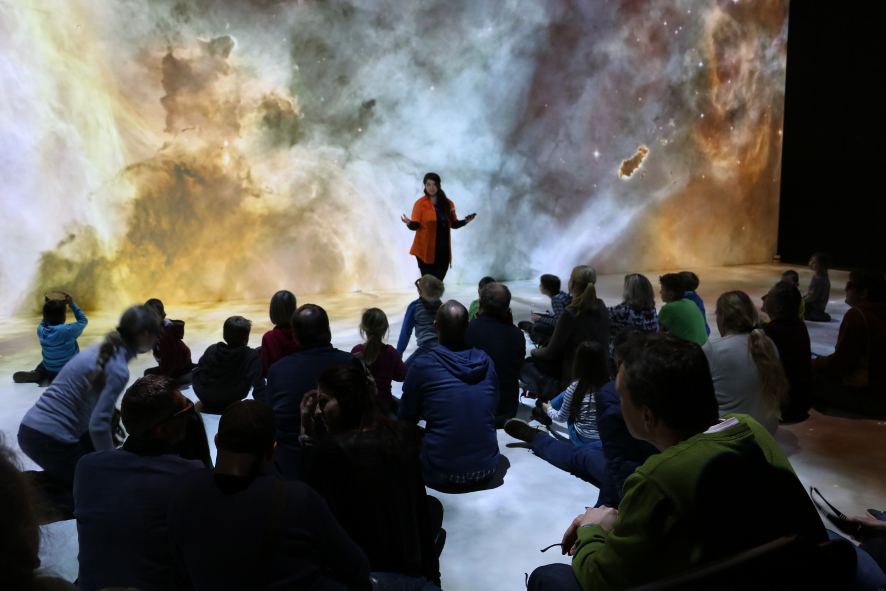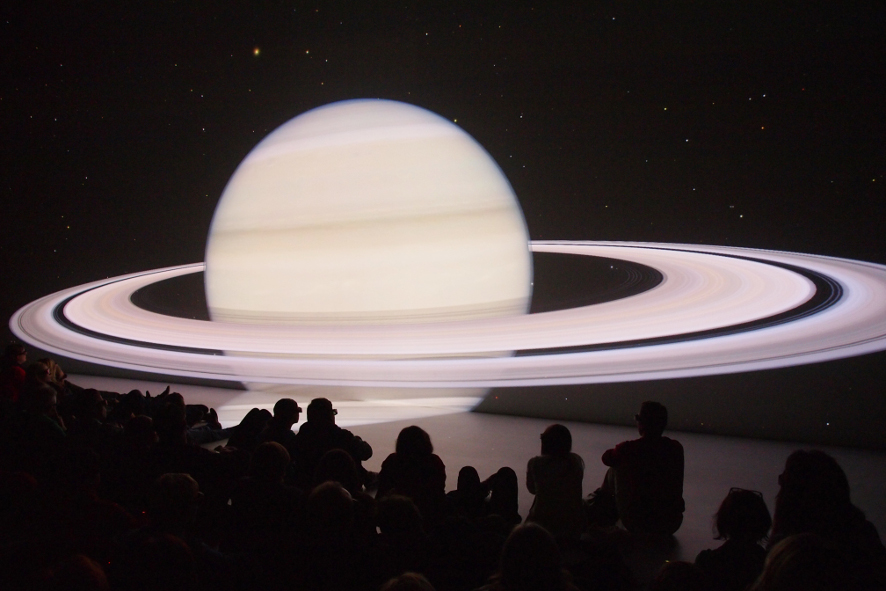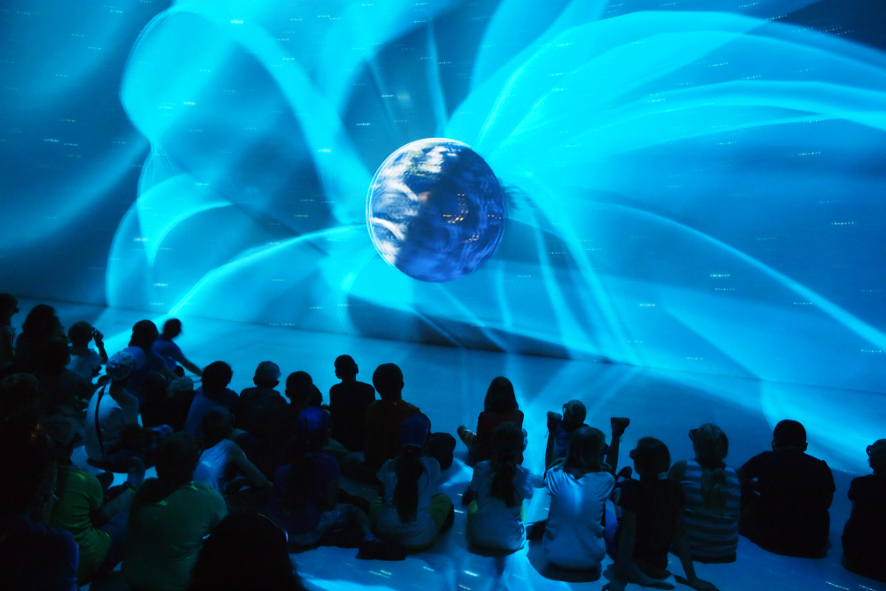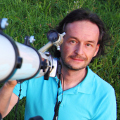For years now, Uniview has been Deep Space’s most popular program. Following the radical technical makeover of Deep Space in summer 2015, this journey through outer space can now be seen in extraordinary 8K resolution. And, as always, it’s a mainstay of the regularly recurring Best of Deep Space 8K presentations.
On Saturday & Sunday, March 5-6, 2016, we’ve even scheduled an entire Deep-Space Weekend entitled Uniview 8K – A Journey into Outer Space in 3-D. One of the featured attractions in Deep Space 8K will be hosted by Herbert Raab and Erich Meyer of the Astronomical Society of Linz: an amazing trip in breathtaking 8K resolution at billions of times the speed of light out of our Solar System, through the Milky Way and past distant galaxies to the theoretical end of the universe. We recently had a chance to chat with the two.

Credit: Magdalena Leitner
What exactly is the Astronomical Society of Linz and who can join?
Herbert Raab: The Astronomical Society of Linz (ASL) is an association of hobby astronomers that, among other activities, runs the Kepler Observatory on Freinberg in Linz. Membership is open to anyone who’s interested in astronomy, who’d like to join a group with like-minded individuals and take advantage of the ASL’s offerings—for instance, members can take out books from our library, borrow a telescope, and take part in our observations. There’s an overview of our activities online at http://www.sternwarte.at.
The Uniview program has been running at Deep Space for several years now. What changes have the technical enhancement to Deep Space 8K brought about in your speeches? For example, does the extremely high 8K resolution enable viewers to see more constellations?
Herbert Raab: The higher resolution is apparent above all when we “do a flyover” of specific heavenly bodies in Uniview—for instance, if we take a close-up look at one of the planets in our Solar System or if we hover above our Milky Way. The high-resolution depiction gives the impression of looking out the big picture window of a space ship.

Credit: Martin Hieslmair
What are the technical requirements for the photographs you use in your speeches, and can they be fulfilled by a telescope?
Erich Meyer: In conjunction with the two speeches I’ll be delivering during the Deep Space theme weekend “Uniview 8K – A Journey into Outer Space in 3-D,” I’ll be using Uniview exclusively. But in my last two speeches, I also used third-party images suitable for Deep Space 8K and I must say, the new requirements for images and videos to be screened in 8K resolution are enormous. You need extraordinarily high-resolution shots. But actually, almost all of today’s telescopes and—even more important—SLR cameras fulfill these preconditions.
Herbert Raab: I’m not using any externally acquired images either for this Deep Space weekend. Here, we’re concentrating completely on Uniview 8K. But of course, Deep Space with its enormously high resolution places high demands on images’ quality. On the other hand, astronomers in particular place tremendous value on technical perfection in image processing, so there’s a huge supply of spectacular shots that we can draw upon.

Credit: Martin Hieslmair
Why do you think that, after all these years, so many visitors still want to see Uniview?
Herbert Raab: I think that people have always been fascinated by the universe and space exploration, and the nearly incessant flow of new insights and discoveries has definitely not diminished that fascination in the least! And the jumbo-format, high-resolution, three-dimensional depictions of the entire universe provided by Uniview in Deep Space really do a great job getting across this fascination.
Erich Meyer: Seeing outer space in 3-D with state-of-the-art technology is an extraordinary experience. Deep Space really does deliver what its name promises!
Herr Raab, your speech will go into the cosmic web. What’s that all about?
Herbert Raab: It’s not the extension of the World Wide Web for astronauts [laughs]. Actually, it refers to the large-scale structure of the universe in which galaxies and galaxy clusters aren’t uniformly dispersed but rather arrayed in a net-like structure.

Credit: Magdalena Leitner
In your second speech, you’ll be discussing our Solar System. Konstantin Batygin and Mike Brown at the California Institute of Technology in Pasadena have purportedly just discovered a ninth planet. Is this really a ninth planet, and why wasn’t it discovered earlier?
Herbert Raab: The fact is that the ninth planet has not yet been directly observed, but the positions of the orbits of objects on the outer edge of our Solar System lead to the conclusion that these orbits have been influenced by the gravity of a far distant planet that is as yet unknown. Accordingly, the so-called Planet IX is still a hypothesis.
Herr Meyer, you’ll be giving visitors interesting glimpses into the past and future of the cosmos. But doesn’t every telescope peer into the universe’s past?
Erich Meyer: Precisely! With a telescope, you always look into the past. Astronomy is what you might call the archeology of space-time. With these insights, it’s possible to comprehend astrophysical interrelationships and, thereby, get a picture of our universe’s future.

Herbert Raab is an Austrian computer scientist, amateur astronomer and asteroid discoverer. He joined in 1983 the Linz Astronomical Community and is since 1996 president of the association and head of the Johannes Kepler observatory Linz. In 1990 he developed the popular software Astrometrica, which is used for astrometric and photometric analysis of recordings of asteroids and comets. Among his most important observations include precision positioning of the comet Shoemaker-Levy 9, which he had together with Erich Meyer and Erwin Obermair 1993, and have significantly contributed to the subsequent impact of this comet on the planet Jupiter predict.

Erich Meyer is an Austrian engineer, amateur astronomer and asteroid discoverer. He discovered between 1996 and 1999 at the private observatory Meyer / Obermair in Davidschlag 21 asteroids, seven of them together with his colleague Erwin Obermair and together with Herbert Raab. In addition, he was involved from 1996 to 2005 six other asteroids. Discoveries that were awarded by the International Astronomical Union from the observatory Davidschlag. On April 4, 1997 Meyer was awarded the Badge of Merit of the Republic of Austria.
You’re cordially invited to join us in the Ars Electronica Center’s Deep Space this coming weekend, Saturday & Sunday, March 5-6, 2016, for Uniview 8K – A Journey into Outer Space in 3-D. On this amazing trip in breathtaking 8K resolution, you’ll travel at billions of times the speed of light out of our Solar System, through the Milky Way and past distant galaxies to the theoretical end of the universe. For additional info, go to https://ars.electronica.art/center/en/2016/01/19/deep-space-wochenende-uniview-8k/.
Tip:
On THU March 3, 2016, 8PM at Deep Space LIVE you already travel with Dietmar Hager in a brilliant 8K resolution to different constellations: https://ars.electronica.art/center/en/2015/12/16/deep-space-live-uniview-8k/
